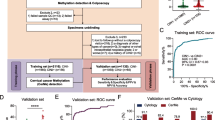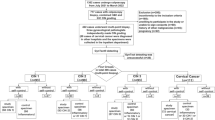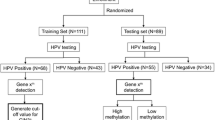Abstract
Cervical cancer is the third most common cancer disease affecting the female population, and a key factor in the development of the disease is the human papillomavirus infection (HPV). The disease is also impacted by epigenetic changes such as DNA methylation, which causes activation or exclusion of certain genes. The aim of our review is to summarize and compare the most common molecular methods for detection of methylated promoter regions in biomarkers occurring in cervical carcinoma and also show the importance of connections of HR-HPV testing with methylation analysis in patients with cervical intraepithelial neoplasia. Insight into genetic and epigenetic alterations associated with cervical cancer development can offer opportunities for the molecular biomarkers that can be useful for screening, diagnosis, and also as new ways of treatment of cervical cancer precursor lesions.
Similar content being viewed by others
References
Ferlay J, Shin HR, Bray F, et al. Estimates of worldwide burden of cancer. GLOBOCAN, 2008.
Sung LC, et al. Methylation markers for diagnosis of cervical cancer, Patent application publication, 2013.
Steenbergen R, Snijders P, Heideman D, et al. Clinical implications of (epi) genetic changes in HPV-induced cervical precancerous lesions. Nat Rev Cancer. 2014;14:395–405.
Arbyn M, Roelens J, Cuschieri K, et al. The APTIMA HPV assay versus the Hybrid Caoture II test in triage of women with ASC-US or LSIL cervical cytology: a meta-analysis of the diagnostic accuracy. Int J Cancer. 2013;132(1):101–8.
Janusicova V, Mendelova A, Zubor P, et al. mRNA Expression in cervical specimens for determination of severe dysplasia or worse in HPV-16/18-positive squamous lesions. J Low Genit Tract Dis. 2014;18(3):273–80.
Fiolka R, Zubor P, Holubekova V, et al. Promoter hypermethylation of the tumor-suppresor genes RASSF1A, GSTP1 and CDH1 in endometrial cancer. Oncol Rep. 2013;30(6):2878–86.
Visnovsky J, Fiolka R, Kudela E, et al. Hypermethylation of selected genes in endometrial carcinogenesis. Neuro Endocrinol Lett. 2013;34(7):675–80.
Culbova M, Lasabova Z, Stanclova A, et al. Metylácia vybraných tumor-supresorových génov v benígnych a malígnych ovariálnych nádoroch. Article in Czech. Česká gynekologie. 2011;76(4):274–9.
Zubor P, Kajo K, Stanclova A, et al. Human epithelial growth factor receptor 2 polymorphism and risk of fibroadenoma. Eur J Cancer Prev. 2008;17(1):33–8.
Thomas LK, Bermejo JL, Vinokurova S, et al. Chromosomal gains and losses in human papillomavirus-associated neoplasia of the lower genital tract—a systematic review and meta-analysis. Eur J Cancer. 2014;50(1):85–98.
Bierkens M, Krijqsman O, Wilting S, et al. Focal aberrations indicate EYA2 and hsa-miR-375 as oncogene and tumor suppressor in cervical carcinogenesis. Genes Chromosom Cancer. 2013;52(1):56–68.
Kudela E, Farkasova A, Visnovsky J, et al. Amplification of 3q26 and 5p15 regions in cervical intraepithelial neoplasia. Acta Obstet Gynecol Scand. 2014;93(10):997–1002.
Visnovsky J, Kudela E, Farkasova A, et al. Amplification of TERT and TERC genes in cervical intraepithelial neoplasia and cervical cancer. Neuro Endocrinol Lett. 2014;35(6):518–22.
Wajed SA, Laird PW, DeMeester TR, et al. DNA methylation: an alternative pathway to cancer. Ann Surg. 2001;234(1):10–20.
Merlo A, Herman JG, Mao L, et al. 5’CpG Island methylation is associated with transcirptional silencing of the tumor suppressor gene p16/CDKN2/MTS1 in human cancers. Nat Med. 1995;1(7):686–92.
Mayrand MH, Duarte-Franco E, Rodrigues I, et al. Human papillomavirus DNA versus Papanicolaou screening tests for cervical cancer. N Engl J Med. 2007;357:1579–88.
Szalmas A, Konya J. Epigenetic alterations in cervical carcinogenesis. Semin Cancer Biol. 2009;19(3):144–52.
Herfs M, Yamamoto Y, Laury A, et al. A discrete population of squamocolumnar junction cells implicated in the pathogenesis of cervical cancer. Proc Natl Acad Sci. 2012;109:10516–21.
Wentzensen N, Sherman ME, Schiffman M, et al. Utility of methylation markers in cervical cancer early detection: appraisal of the state-of-the science. Gynecol Oncol. 2009;112(2):293–9.
Hesselink AT, Heideman DA, Steenbergen RD, et al. Combined promoter methylation analysis of CADM1 and MAL: an objective triage tool for high-risk human papillomavirus DNA-positive women. Clin Cancer Res. 2011;17:2459–65.
Eijsink JJ, Lendvai Á, Deregowski V, et al. A four-gene methylation marker panel as triage test in hig-hrisk human papillomavirus positive patients. Int J Cancer. 2012;130(8):1861–9.
Bierkens M, Hesselink AT, Meijer CJ, et al. CADM1 and MAL promoter methylation levels in hrHPV-positive cervical scrapes increase proportional to degree and duration of underlying cervical disease. Int J Cancer. 2013;133:1293–9.
Fraga MF, Esteller M. DNA methylation: a profile of methods and applications. Biotechniques. 2002;33(4):6–49.
Swift- Scanlan T, Blackford A, Argani P, et al. Two-color quantitative multiplex methylation-specific PCR. Biotechniques. 2006;40(2):210–9.
Jiménez I, Cardeñosa EE, Suela SP, et al. Advantages of the high resolution melting in the detection of BRCA1 or BRCA2 mutation carriers. Clin Biochem. 2009;42:1572–6.
Snellenberg S, De Strooper LM, Hesselink AT, et al. Development of a multiplex methylation-specific PCR as candidate triage test for women with an HPV-positive cervical scrape. BMC Cancer. 2012;12:551.
Bian YS, Yan P, Osterheld MC, et al. Promoter methylation analysis on microdissected paraffin-embedded tissues using bisulfi te treatment and PCR- SSCP. Biotechniques. 2001;30(1):66–72.
Steenbergen RD, Kramer D, Braahuis BJ, et al. TSLC1 gene silencing in cervical cancer cell lines and cervical neoplasia. J Natl Cancer Inst. 2004;96(4):294–305.
Xiong Z, Laird PW. COBRA: a sensitive and quantitative DNA methylation assay. Nucleic Acids Res. 1997;25(12):2532–4.
Rauch TA, Pfeifer GP. The MIRA method for DNA methylation analysis. Methods Mol Biol. 2009;507:65–75.
Hyman ED. A new method of sequencing DNA. Anal Biochem. 1988;174:423–36.
Mikeska T, Felsberg J, Hewitt CA, et al. Analysing DNA methylation using bisulphite pyrosequencing. Methods Mol Biol. 2011;791:33–53.
Kyrgiou M, Koliopoulos G, Martin-Hirsch P, et al. Obstetric outcomes after conservative treatment for intraepithelial or early invasive cervical lesions: systematic review and meta-analysis. Lancet. 2006;367(9509):489–98.
Wright AA, Howitt BB, Myers AP, et al. Oncogenic mutations in cervical cancer: genomic differences between adenocarcinomas and squamous cell carcinomas of the cervix. Cancer. 2013;119:3776–83.
Kocken J, Helmerhorst TJ, Bekhof J, et al. Risk of recurrent high-grade cervical intraepithelial neoplasia after successful treatment: a long-term multi-cohort study. Lancet Oncol. 2011;12(5):441–50.
Arbyn M, Kyrgiou M, Simoens C, et al. Perinatal mortality and other severe adverse pregnancy outcomes associated with treatment of cervical intraepithelial neoplasia: meta-analysis. BMJ. 2008;337:284.
Acknowledgments
This work was supported by the project “Molecular diagnostics of cervical cancer” (ITMS:26220220113), Comenius University Grants 303/2011, 242/2012, 287/2015, 121/2015, and the VEGA Grant 1/0271/12 as well as the APVV-0224-12 grant.
Author information
Authors and Affiliations
Corresponding author
Ethics declarations
Conflicts of interest
None
Rights and permissions
About this article
Cite this article
Mersakova, S., Nachajova, M., Szepe, P. et al. DNA methylation and detection of cervical cancer and precancerous lesions using molecular methods. Tumor Biol. 37, 23–27 (2016). https://doi.org/10.1007/s13277-015-4197-1
Received:
Accepted:
Published:
Issue Date:
DOI: https://doi.org/10.1007/s13277-015-4197-1




